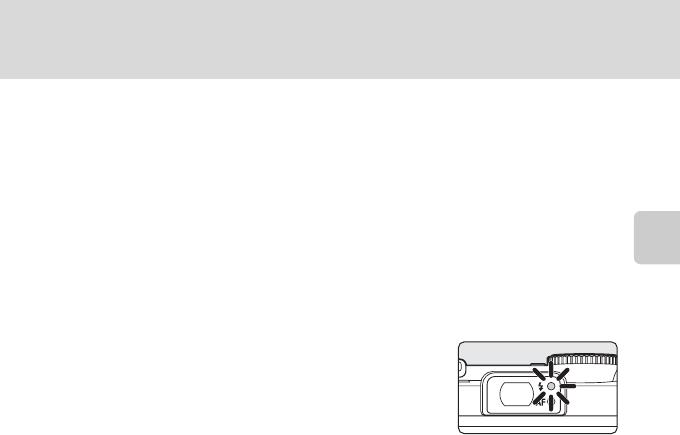
31
Using the Flash
Basic Photography and Playback: Auto Mode
B Shooting When Lighting Is Poor and the Flash Is Disabled (W)
• Use of a tripod is recommended to stabilize the camera during shooting and avoid the effects of
camera shake. Turn vibration reduction (A128) off when using a tripod.
• Place the camera on a flat, level surface or use a tripod (recommended).
• The E symbol is displayed when the camera automatically increases sensitivity to minimize blur
caused by slow shutter speed. Pictures shot when E is displayed may be slightly mottled.
B Note on Using the Flash
When using the flash at a wide-angle zoom position, reflections from dust particles in the air may
appear as bright spots in pictures. To reduce these reflections, set the flash to W (Off) or zoom in on
the subject.
C The Flash Lamp
The flash lamp indicates flash status when the shutter-release
button is pressed halfway.
• On:Flash will fire when picture is shot.
• Blinks:Flash charging. Wait a few seconds and try again.
• Off:Flash will not fire when picture is shot.
When pictures are shot using the flash and a low battery, the
monitor display will turn off and the flash lamp will blink until the flash is fully charged.
C The Flash Mode Setting
In A (auto), high-sensitivity shooting, P, S, A, and M modes, the default setting is U (auto).
When any flash mode other than V (auto with red-eye reduction) is applied in A (auto) mode,
the setting is only enabled until the camera is turned off. Turning the camera off returns flash mode
to U (auto). When flash mode is applied in a scene mode, the setting is only enabled until
another shooting mode is selected or the camera is turned off.
C Red-eye Reduction
This camera uses advanced red-eye reduction (“In-Camera Red-Eye Fix”). The flash fires repeatedly at
low intensity before the main flash, reducing red-eye. The camera then analyzes the picture; if red-
eye is detected, the affected area will be processed to further reduce red-eye before the picture is
saved. Note that because there is a slight lag between the shutter-release button being pressed and
the picture being shot, this mode is not recommended when a quick shutter response is required.
The time before the next picture can be shot also increases slightly. Advanced red-eye reduction
may not produce the desired results in all situations. In extremely rare instances, areas not subject to
red-eye may be affected by advanced red-eye reduction processing; in these cases, choose another
mode and try again.
D More Information
See “Using Optional Speedlights” (A 139) for more information.


















